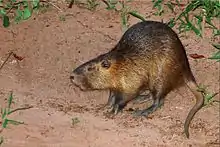List of mammals of Texas
This is a list of mammals of Texas, those mammals native to or immediately off the coast of the U.S. state of Texas.

The varying geography of Texas, the second largest state, provides a large variety of habitats for mammals. The land varies from swamps, Piney Woods in the east, rocky hills and limestone karst in the central Hill Country of the Edwards Plateau, desert in the south and west, mountains in the far west (the Trans-Pecos), and grassland prairie in the north, also known as the Panhandle.[1][2][3] The state's many rivers, including the Rio Grande, the Colorado River, and the Trinity River, also provide diverse river habitats.[4][5] Its central position in the United States means that species found primarily in either the western or eastern reaches of the country often have their ranges meeting in the state. Additionally, its proximity to Mexico is such that many species found there and into Central America also range as far north as Texas.[1]
Texas recognizes three official mammals: the nine-banded armadillo, the Texas Longhorn, and the Mexican free-tailed bat. State law protects numerous species.
List of species
Dasypodidae
Dasypodidae is a family of armoured mammals found mainly in Latin America.[6]
| Species | Common name | Distribution | Status[a] | Image |
|---|---|---|---|---|
| Dasypus novemcinctus | Nine-banded armadillo | Found in all of Texas, except the Trans-Pecos region[7] |  | |
Phyllostomidae
| Species | Common name | Distribution | Status | Image |
|---|---|---|---|---|
| Choeronycteris mexicana | Mexican long-tongued bat | Only found in South Texas; may be slowly increasing distribution northward.[8] | .jpg.webp) | |
| Diphylla ecaudata | Hairy-legged vampire bat | Only one specimen found in 1967, in Val Verde County.[8] | .jpg.webp) | |
| Leptonycteris nivalis | Greater long-nosed bat | Only found in Presidio County and Brewster County.[8] | 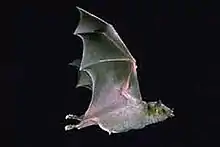 | |
Mormoopidae
| Species | Common name | Distribution | Status | Image |
|---|---|---|---|---|
| Mormoops megalophylla | Ghost-faced bat | Found in the Trans-Pecos, South Texas Plains, and the southern edge of the Edwards Plateau.[9] |  | |
Vespertilionidae
| Species | Common name | Distribution | Status | Image |
|---|---|---|---|---|
| Aeorestes cinereus | Hoary bat | Found in mature forested areas across the state[8] | .jpg.webp) | |
| Antrozous pallidus | Pallid bat | Commonly found in the western half of Texas, including the panhandle.[10][8] | .jpg.webp) | |
| Corynorhinus rafinesquii | Rafinesque's big-eared bat | Found in small localities in the Pineywoods of East Texas.[8] | 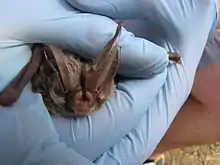 | |
| Corynorhinus townsendii | Townsend's big-eared bat | Commonly found in the western half of Texas, including the panhandle. Population in West Texas and Panhandle are divided into subspecies.[8] |  | |
| Dasypterus ega | Southern yellow bat | Found in seven counties in the Rio Grande Valley.[8] | 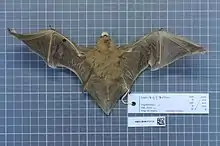 | |
| Dasypterus intermedius | Northern yellow bat | Occurs in the eastern and southern part of the state, including along the coast.[8] | 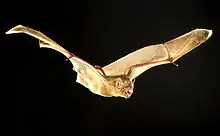 | |
| Dasypterus xanthinus | Western yellow bat | Reported in the southernmost counties of Texas surrounding Big Bend National Park.[8] | 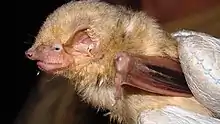 | |
| Eptesicus fuscus | Big brown bat | Found primarily iy the eastern, northern and western parts of the state.[8] | 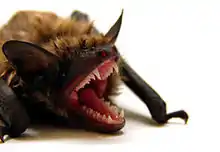 | |
| Euderma maculatum | Spotted bat | Found only in Big Bend National Park.[8] |  | |
| Lasionycteris noctivagans | Silver-haired bat | Found in forested areas across the state, not seen often in cities.[8] |  | |
| Lasiurus blossevillii | Desert red bat | One specimen found in Presidio County in 1988[8] | 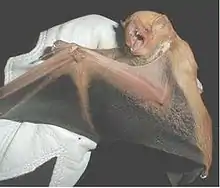 | |
| Lasiurus borealis | Eastern red bat | Found state-wide, but most commonly found in the eastern and central part of the state[8] | 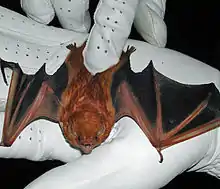 | |
| Lasiurus seminolus | Seminole bat | Found in the eastern part of the state[8] | .jpg.webp) | |
| Myotis austroriparius | Southeastern myotis | Found in eastern Texas caves[8] | 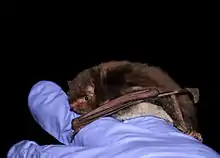 | |
| Myotis californicus | California myotis | Found primarily in the Chihuahuan Desert and Trans-Pecos region of Texas[8] | .jpg.webp) | |
| Myotis ciliolabrum | Western small-footed myotis | Found primarily in the Trans-Pecos mountains and small populations in the panhandle[8] | 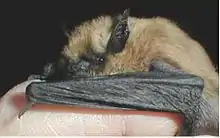 | |
| Myotis occultus | Arizona myotis | |||
| Myotis septentrionalis | Northern long-eared myotis | |||
| Myotis thysanodes | Fringed myotis | |||
| Myotis velifer | Cave myotis | |||
| Myotis volans | Long-legged myotis | |||
| Myotis yumanensis | Yuma myotis | |||
| Nycticeius humeralis | Evening bat | |||
| Pipistrellus hesperus | Western pipistrelle | |||
| Pipistrellus subflavus | Eastern pipistrelle | |||
Molossidae
| Species | Common name | Distribution | Status | Image |
|---|---|---|---|---|
| Eumops perotis | Western mastiff bat | Found in Val Verde, Terrell, Brewster, and Presidio counties in South Texas and in Midland County in the west[8] | 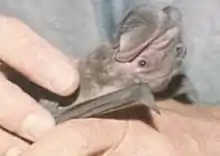 | |
| Nyctinomops femorosacca | Pocketed free-tailed bat | Found in Val Verde, Terrell, Brewster, and Presidio counties in South Texas.[8] | .jpg.webp) | |
| Nyctinomops macrotis | Big free-tailed bat | Scattered localities in the Panhandle, Trans-Pecos region, and recently in Wise County[8] | 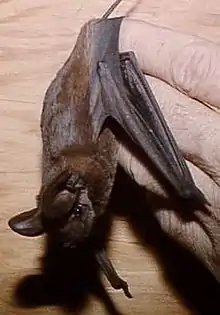 | |
| Tadarida brasiliensis | Mexican free-tailed bat | State-wide distribution in the summer, with the eastern population being year-round residents[8] | 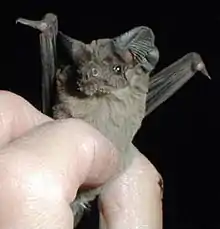 |
Canidae
| Species | Common name | Distribution | Status | Image |
|---|---|---|---|---|
| Canis latrans | Coyote | ubiquitous throughout Texas | 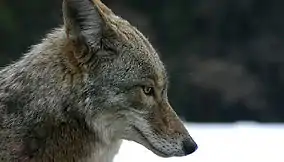 | |
| Canis lupus | Gray wolf | all subspecies previously found in Texas are either extinct or extirpated; see below | 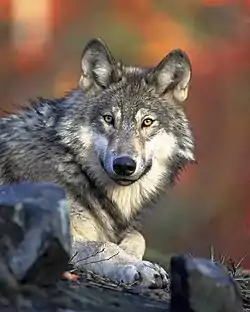 | |
| Canis lupus baileyi | Mexican wolf | extirpated | 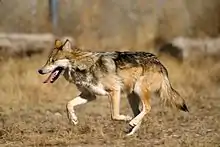 | |
| Canis lupus monstrabilis | Texas wolf | extinct | _C._l._monstrabilis_mod.jpg.webp) | |
| Canis lupus nubilus | Great Plains wolf | extinct | _C._l._nubilus_mod.jpg.webp) | |
| Canis lupus rufus | Red wolf | extirpated | .jpg.webp) | |
| Urocyon cinereoargenteus | Gray fox | .jpg.webp) | ||
| Vulpes macrotis | Kit fox | 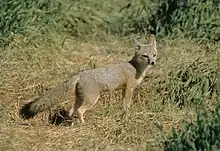 | ||
| Vulpes velox | Swift fox | 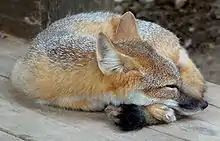 |
Felidae
Procyonidae
| Species | Common name | Distribution | Status | Image |
|---|---|---|---|---|
| Bassariscus astutus | Ring-tailed cat | Common in the Trans-Pecos, Edwards Plateau and Cross Timbers ecoregions, but also seen statewide except the panhandle[8] |  | |
| Nasua narica | White-nosed coati | Recently, only seen in the Big Bend and Padre Island regions[8] | 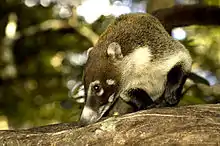 | |
| Procyon lotor | Raccoon | Ubiquitous throughout Texas | _3.jpg.webp) | |
Mephitidae
| Species | Common name | Distribution | Status | Image |
|---|---|---|---|---|
| Conepatus leuconotus | American hog-nosed skunk | 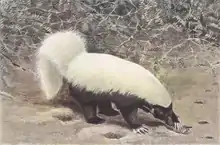 | ||
| Mephitis macroura | Hooded skunk | .jpg.webp) | ||
| Mephitis mephitis | Striped skunk | _DSC_0030.jpg.webp) | ||
| Spilogale gracilis | Western spotted skunk | 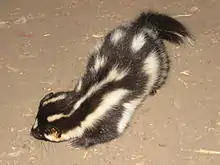 | ||
| Spilogale putorius | Eastern spotted skunk | .jpg.webp) | ||
Mustelidae
- North American river otter (Lontra canadensis)
- Long-tailed weasel (Mustela frenata)
- Black-footed ferret (Mustela nigripes) extirpated
- American mink (Neovison vison)
- American badger (Taxidea taxus)
Ursidae
| Species | Common name | Distribution | Status | Image |
|---|---|---|---|---|
| Ursus americanus | American black bear | Found in the forested areas of east Texas, the Trans-Pecos region, and at the tip of the Panhandle[8] | ||
| Ursus arctos | Brown bear | all subspecies once present in Texas are either extirpated or extinct; see below | ||
| Ursus arctos horribilis | Grizzly bear | extirpated; the only documented grizzly bear (U. a. horribilis) specimen was killed in 1905 in Jeff Davis County[8] | ||
| Ursus arctos nelsoni | Mexican grizzly bear | extinct[11][12] | ||
Tayassuidae
| Species | Common name | Distribution | Status | Image |
|---|---|---|---|---|
| Pecari tajacu | Collared peccary | Mostly restricted to western Texas and south of San Antonio. Introduced populations occur in north Texas[8] | 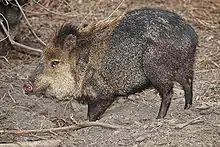 | |
Cervidae
- Elk (Cervus canadensis)
- Merriam's elk (Cervus canadensis merriami) extinct
- Mule deer (Odocoileus hemionus)
- White-tailed deer (Odocoileus virginianus)
Antilocapridae
| Species | Common name | Distribution | Status | Image |
|---|---|---|---|---|
| Antilocapra americana | Pronghorn | Native to Central and Western Texas; considered the pronghorn's easternmost range | 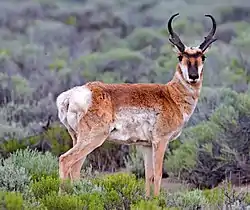 | |
Bovidae
- American bison (Bison bison)
- Plains bison (Bison bison bison) reintroduced
- Bighorn sheep (Ovis canadensis)
- Desert bighorn sheep (Ovis canadensis nelsoni)
Soricidae
| Species | Common name | Distribution | Status | Image |
|---|---|---|---|---|
| Blarina carolinensis | Southern short-tailed shrew | 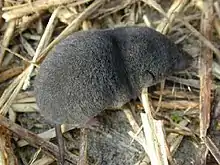 | ||
| Blarina hylophaga | Elliot's short-tailed shrew | |||
| Cryptotis parva | North American least shrew | |||
| Notiosorex crawfordi | Crawford's gray shrew | |||
Talpidae
| Species | Common name | Distribution | Status | Image |
|---|---|---|---|---|
| Scalopus aquaticus | Eastern mole | Documented in the eastern two-thirds of the state, eastern areas of South Texas, along the Canadian River drainage in the Panhandle, and in Presidio County in the west[13] | 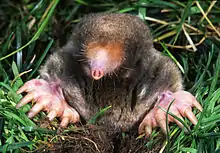 | |
Trichechidae
| Species | Common name | Distribution | Status | Image |
|---|---|---|---|---|
| Trichechus manatus | West Indian manatee | Rare in Texas waters, but observed in the Laguna Madre, Cow Bayou, and near Sabine Lake, Copano Bay, San José Island, Bolivar Peninsula, and the mouth of the Rio Grande[15] |  | |
Didelphidae
| Species | Common name | Distribution | Status | Image |
|---|---|---|---|---|
| Didelphis virginiana | Virginia opossum | Found throughout the state except for the arid Trans-Pecos and Llano Estacado[16] | 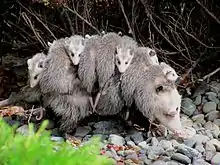 | |
Leporidae
| Species | Common name | Distribution | Status | Image |
|---|---|---|---|---|
| Lepus californicus | Black-tailed jackrabbit | _-_Google_Art_Project.jpg.webp) | ||
| Sylvilagus aquaticus | Swamp rabbit | _(6260425611).jpg.webp) | ||
| Sylvilagus audubonni | Desert cottontail |  | ||
| Sylvilagus floridanus | Eastern cottontail |  | ||
Castoridae
| Species | Common name | Distribution | Status | Image |
|---|---|---|---|---|
| Castor canadensis | North American beaver | 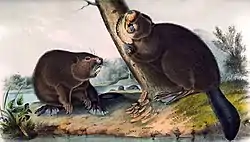 | ||
Cricetidae
- Northern pygmy mouse (Baiomys taylori)
- Mexican vole (Microtus mexicanus)
- Woodland vole (Microtus pinetorum)
- Prairie vole (Microtus ochrogaster)
- White-throated woodrat (Neotoma albigula)
- Florida woodrat (Neotoma floridana)
- Mexican woodrat (Neotoma mexicana)
- Southern plains woodrat (Neotoma micropus)
- Golden mouse (Ochrotomys nuttalli)
- Muskrat (Ondatra zibethicus)
- Chihuahuan grasshopper mouse (Onychomys arenicola)
- Northern grasshopper mouse (Onychomys leucogaster)
- Coues' rice rat (Oryzomys couesi)
- Marsh rice rat (Oryzomys palustris)
- Texas mouse (Peromyscus attwateri)
- Brush mouse (Peromyscus boylii)
- Cactus mouse (Peromyscus eremicus)
- Cotton mouse (Peromyscus gossypinus)
- White-footed mouse (Peromyscus leucopus)
- Deer mouse (Peromyscus maniculatus)
- White-ankled mouse (Peromyscus pectoralis)
- Northern rock mouse (Peromyscus nasutus)
- Pinyon mouse (Peromyscus truei)
- Eastern harvest mouse (Reithrodontomys humulis)
- Fulvous harvest mouse (Reithrodontomys fulvescens)
- Western harvest mouse (Reithrodontomys megalotis)
- Plains harvest mouse (Reithrodontomys montanus)
- Tawny-bellied cotton rat (Sigmodon fulviventer)
- Hispid cotton rat (Sigmodon hispidus)
- Yellow-nosed cotton rat (Sigmodon ochrognathus)
Erethizontidae
| Species | Common name | Distribution | Status | Image |
|---|---|---|---|---|
| Erethizon dorsatum | North American porcupine | |||
Geomyidae
- Yellow-faced pocket gopher (Cratogeomys castanops)
- Desert pocket gopher (Geomys arenarius)
- Attwater's pocket gopher (Geomys attwateri)
- Botta's pocket gopher (Thomomys bottae)
- Baird's pocket gopher (Geomys breviceps)
- Plains pocket gopher (Geomys bursarius)
- Knox Jones's pocket gopher (Geomys knoxjonesi)
- Texas pocket gopher (Geomys personatus)
- Llano pocket gopher (Geomys texensis)
Heteromyidae
- Hispid pocket mouse (Chaetodipus hispidus)
- Rock pocket mouse (Chaetodipus intermedius)
- Nelson's pocket mouse (Chaetodipus nelsoni)
- Desert pocket mouse (Chaetodipus penicillatus)
- Gulf Coast kangaroo rat (Dipodomys compactus)
- Texas kangaroo rat (Dipodomys elator)
- Merriam's kangaroo rat (Dipodomys merriami)
- Ord's kangaroo rat (Dipodomys ordii)
- Banner-tailed kangaroo rat (Dipodomys spectabilis)
- Mexican spiny pocket mouse (Liomys irroratus)
- Plains pocket mouse (Perognathus flavescens)
- Silky pocket mouse (Perognathus flavus)
- Merriam's pocket mouse (Perognathus merriami)
Sciuridae
- Texas antelope squirrel (Ammospermophilus interpres)
- Black-tailed prairie dog (Cynomys ludovicianus)
- Southern flying squirrel (Glaucomys volans)
- Gray-footed chipmunk (Neotamias canipes)
- Eastern gray squirrel (Sciurus carolinensis)
- Fox squirrel (Sciurus niger)
- Mexican ground squirrel (Spermophilus mexicanus)
- Spotted ground squirrel (Spermophilus spilosoma)
- Thirteen-lined ground squirrel (Spermophilus tridecemlineatus)
- Rock squirrel (Spermophilus variegatus)
Balaenidae
| Species | Common name | Distribution | Status | Image |
|---|---|---|---|---|
| Eubalaena glacialis | North Atlantic right whale | |||
Balaenopteridae
| Species | Common name | Distribution | Status | Image |
|---|---|---|---|---|
| Balaenoptera acutorostrata | Minke whale | Seen stranded occasionally, rare sightings. Last seen in Texas in the 1980s.[17][8] | ||
| Balaenoptera brydei Balaenoptera edeni | Bryde's whale | Seen yearly in every season but the fall in shallow waters. Taxonomy up to debate[8][17] | ||
| Balaenoptera musculus | Blue whale | |||
| Balaenoptera physalus | Fin whale | |||
| Megaptera novaeangliae | Humpback whale | |||
Kogiidae
Kogiidae is a family of whales.
| Species | Common name | Distribution | Status | Image |
|---|---|---|---|---|
| Kogia breviceps | Pygmy sperm whale | |||
| Kogia simus | Dwarf sperm whale | 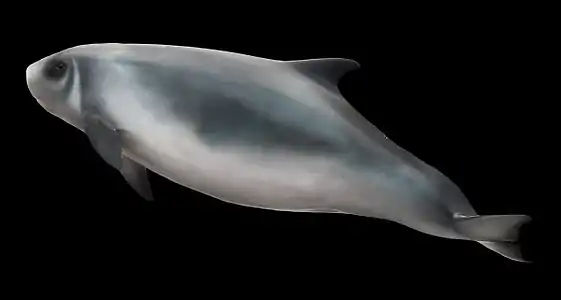 | ||
Physeteridae
Physeteridae is a monotypic family of whales only containing the extant Physeter macrocephalus.
| Species | Common name | Distribution | Status | Image |
|---|---|---|---|---|
| Physeter macrocephalus | Sperm whale | |||
Ziphiidae
| Species | Common name | Distribution | Status | Image |
|---|---|---|---|---|
| Mesoplodon densirostris | Blainville's beaked whale |  | ||
| Mesoplodon europaeus | Gervais' beaked whale | |||
| Ziphius cavirostris | Cuvier's beaked whale | |||
Delphinidae
| Species | Common name | Distribution | Status | Image |
|---|---|---|---|---|
| Delphinus delphis | Short-beaked common dolphin | |||
| Feresa attenuata | Pygmy killer whale | |||
| Globicephala macrorhynchus | Short-finned pilot whale | |||
| Grampus griseus | Risso's dolphin | |||
| Orcinus orca | Killer whale | Uncommon in Texas waters, rare and poorly documented strandings, occasionally seen off South Padre Island[18] |  | |
| Pseudorca crassidens | False killer whale | |||
| Peponocephala electra | Melon-headed whale | |||
| Stenella frontalis | Atlantic spotted dolphin | |||
| Stenella attenuata | Pantropical spotted dolphin | |||
| Stenella coeruleoalba | Striped dolphin | |||
| Stenella clymene | Clymene dolphin | |||
| Stenella longirostris | Spinner dolphin | |||
| Steno brenadensis | Rough-toothed dolphin | |||
| Tursiops truncatus | Common bottlenose dolphin | |||
Introduced/invasive mammals
Order Primates
| Species | Common name | Distribution | Status | Image |
|---|---|---|---|---|
| Macaca fuscata | Japanese macaque | Introduced to a sanctuary in Frio County[19][20] | ||
Canidae (canids)
| Species | Common name | Distribution | Status | Image |
|---|---|---|---|---|
| Vulpes vulpes | Red fox | While native to North America, red foxes were introduced to Texas and have expanded over most of the state, except the far western and southern regions[8][21][22] | .jpg.webp) |
Suidae (pigs)
| Species | Common name | Distribution | Status | Image |
|---|---|---|---|---|
| Sus scrofa | Wild boar | Ubiquitous throughout Texas | .jpg.webp) | |
Cervidae (deer)
| Species | Common name | Distribution | Status | Image |
|---|---|---|---|---|
| Axis axis | Chital | |||
| Cervus elaphus | Red deer | |||
| Cervus nippon | Sika deer | |||
| Dama dama | Fallow deer | |||
| Rusa unicolor | Sambar deer | |||
Bovidae (antelopes & sheep)
| Species | Common name | Distribution | Status | Image |
|---|---|---|---|---|
| Ammotragus lervia | Barbary sheep | |||
| Antilope cervicapra | Blackbuck | |||
| Boselaphus tragocamelus | Nilgai | |||
| Oryx gazella | Gemsbok | |||
Muridae (Old World mice & rats)
| Species | Common name | Distribution | Status | Image |
|---|---|---|---|---|
| Mus musculus | House mouse | Ubiquitous throughout Texas | ||
| Rattus norvegicus | Brown rat | Widespread throughout Texas, however not as common in the southern half of Texas as Rattus rattus[8] | 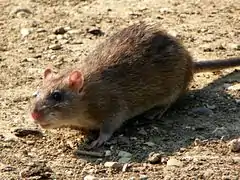 | |
| Rattus rattus | Black rat | Ubiquitous throughout Texas | 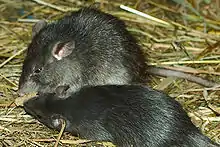 | |
See also
Notes and references
Notes
^ a: Conservation status at a world level of the species according to the IUCN Red List: Conservation status - IUCN Red List of Threatened Species:
- EX - Extinct
- EW - Extinct in the wild
- CR - Critically endangered
- EN - Endangered
- VU - Vulnerable
- NT - Near threatened
- LC - Least concern
- DD - Data deficient
- NE - Not evaluated
Citations
- "Texas Ecoregions". Texas Parks & Wildlife Department. Archived from the original on November 5, 2020. Retrieved October 3, 2020.
- "Native Habitats & Ecosystems". Audubon. Archived from the original on March 16, 2018. Retrieved October 3, 2020.
- "Ecoregion Download Files by State - Region 6". Environmental Protection Agency. Archived from the original on July 25, 2020. Retrieved October 3, 2020.
- "Texas River Guide". Texas Parks & Wildlife Department. Archived from the original on September 29, 2020. Retrieved October 3, 2020.
- "Texas". National Wild and Scenic Rivers System. Archived from the original on October 2, 2020. Retrieved October 3, 2020.
- "Armadillo". Britannica. Archived from the original on October 18, 2020. Retrieved October 16, 2020.
- "Nine-Banded Armadillo". Texas Parks & Wildlife Department. Archived from the original on October 18, 2020. Retrieved October 12, 2020.
- Schmidley, David. "The Mammals of Texas, Online Edition (7th Edition)". Texas Tech Natural Science Research Laboratory. University of Texas Press. Archived from the original on 24 October 2020. Retrieved 17 October 2020.
- "Ghost-faced Bat (Mormoops megalophylla)". Texas Parks & Wildlife Department. Archived from the original on October 14, 2020. Retrieved October 13, 2020.
- "Pallid Bat (Antrozous pallidus)". Texas Parks & Wildlife Department. Archived from the original on October 17, 2020. Retrieved October 16, 2020.
- Meyer, John R. (December 2006). "The Last Texas Grizzly". Texas Parks & Wildlife. Archived from the original on August 10, 2020. Retrieved October 12, 2020.
- "Mexican grizzly bear (extinct)". Bear Conversation. Archived from the original on December 27, 2019. Retrieved October 12, 2020.
- "Eastern Mole". Natural Science Research Laboratory. Texas Tech University. Archived from the original on October 19, 2020. Retrieved October 16, 2020.
- Matson, J., Woodman, N., Castro-Arellano, I. & de Grammont, P.C. (2015). "Scalopus aquaticus". IUCN Red List of Threatened Species. 2016: e.T41471A115188304. doi:10.2305/IUCN.UK.2016-3.RLTS.T41471A22319923.en.CS1 maint: uses authors parameter (link){{cite iucn}}: error: |doi= / |page= mismatch (help)
- "West Indian Manatee". Natural Science Research Laboratory. Texas Tech University. Retrieved October 16, 2020.
- "Virginia Opossum (Didelphis virginiana)". Texas Parks & Wildlife Department. Archived from the original on October 17, 2020. Retrieved October 16, 2020.
- Würsig, Bernd (27 June 2017). Habitats and Biota of the Gulf of Mexico: Before the Deepwater Horizon Oil Spill. New York, NY: Springer. pp. 1489–1587. ISBN 978-1-4939-3456-0. Archived from the original on 26 October 2020. Retrieved 22 October 2020.
- "Killer Whale". Natural Science Research Laboratory. Texas Tech University. Archived from the original on October 18, 2020. Retrieved October 24, 2020.
- Baker, Ed (5 August 2005). "The Legendary Snow Monkeys of Texas: A brief open season on monkeys resulted in protections for them in the Lone Star State". The Austin Chronicle. Archived from the original on 5 June 2011. Retrieved 3 May 2011.
- Born Free USA: Primate Sanctuary: About the Sanctuary, 2003–2011, archived from the original on 20 April 2011, retrieved 3 May 2011
- Potts, Allen (1912). Fox Hunting in America. Washington: The Carnahan Press. pp. 7, 38. Retrieved 9 July 2016.
- "Introducing Mammals to Young Naturalists - Red Foxes". Texas Parks & Wildlife. Texas Parks & Wildlife. Archived from the original on 23 October 2020. Retrieved 22 October 2020.
- "Nutria". Natural Science Research Laboratory. Texas Tech University. Archived from the original on October 17, 2020. Retrieved October 17, 2020.
